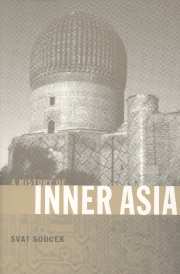Book contents
- Frontmatter
- Contents
- List of maps
- Preface
- Introduction
- 1 The beginnings
- 2 The Kök Turks, the Chinese expansion, and the Arab conquest
- 3 The Samanids
- 4 The Uighur kingdom of Qocho
- 5 The Qarakhanids
- 6 Seljukids and Ghaznavids
- 7 The conquering Mongols
- 8 The Chaghatayids
- 9 Timur and the Timurids
- 10 The last Timurids and the first Uzbeks
- 11 The Shaybanids
- 12 The rise of Russia, the fall of the Golden Horde, and the resilient Chaghatayids
- 13 The Buddhist Mongols
- 14 Bukhara, Khiva, and Khoqand in the seventeenth to nineteenth centuries
- 15 The Russian conquest and rule of Central Asia
- 16 From Governorates-General to Union Republics
- 17 Soviet Central Asia
- 18 Central Asia becomes independent
- 19 Sinkiang as part of China
- 20 Independent Central Asian Republics
- 21 The Republic of Mongolia
- Summary and conclusion
- Appendix 1 Dynastic tables
- Appendix 2 Country data
- Select bibliography
- Index
14 - Bukhara, Khiva, and Khoqand in the seventeenth to nineteenth centuries
Published online by Cambridge University Press: 05 June 2012
- Frontmatter
- Contents
- List of maps
- Preface
- Introduction
- 1 The beginnings
- 2 The Kök Turks, the Chinese expansion, and the Arab conquest
- 3 The Samanids
- 4 The Uighur kingdom of Qocho
- 5 The Qarakhanids
- 6 Seljukids and Ghaznavids
- 7 The conquering Mongols
- 8 The Chaghatayids
- 9 Timur and the Timurids
- 10 The last Timurids and the first Uzbeks
- 11 The Shaybanids
- 12 The rise of Russia, the fall of the Golden Horde, and the resilient Chaghatayids
- 13 The Buddhist Mongols
- 14 Bukhara, Khiva, and Khoqand in the seventeenth to nineteenth centuries
- 15 The Russian conquest and rule of Central Asia
- 16 From Governorates-General to Union Republics
- 17 Soviet Central Asia
- 18 Central Asia becomes independent
- 19 Sinkiang as part of China
- 20 Independent Central Asian Republics
- 21 The Republic of Mongolia
- Summary and conclusion
- Appendix 1 Dynastic tables
- Appendix 2 Country data
- Select bibliography
- Index
Summary
BUKHARA
When Abdallah II died in 1598, his son and successor Abdalmumin, who had spent a number of years as governor of Balkh, managed to stay on the throne only a few months before he was ousted and killed in the disorders that followed his father's death. No other adult male son of Abdallah II had survived to take over – a curious feature in a system where a plethora of sons and grandsons born of a ruler's several wives was often the problem; it seems that in this case Abdallah II, perhaps inspired by the example of his allies the Ottomans but applying his own modified version, had suppressed all the male contenders for succession except Abdalmumin.
What Abdallah did not do, however, was to eliminate his brother-in-law Jani Muhammad, whose father Yar Muhammad had taken refuge with the Shaybanids of Bukhara after the conquest of the khanate of Astrakhan by the Russians in 1556. Jani Muhammad married the Uzbek khan's sister, and he acceded to the vacated throne in Bukhara as the first ruler of a dynasty called Janid or Ashtarkhanid; the Janids too were Juchids, but not through Shiban but through Tuqay Timur, one of Juchi's other sons (in fact, his thirteenth son), so that some historians prefer the name “Tuqay-Timurids” to the genealogically less revealing appellations Janids or Ashtarkhanids.
- Type
- Chapter
- Information
- A History of Inner Asia , pp. 177 - 194Publisher: Cambridge University PressPrint publication year: 2000



